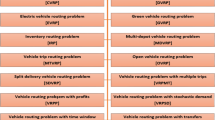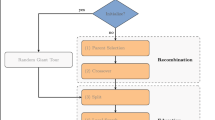Abstract
This paper presents a new generalized vehicle routing problem with a cross-dock. Basic features of the examined problem are the many-to-many relationship between the suppliers and customers, and the use of different vehicle fleets for performing the inbound and outbound routes. An adaptive memory programming method has been developed coupled with a Tabu Search algorithm. For generating new provisional solutions, elite subroutes with varying lengths are identified from the reference solutions and are used as building blocks, while multiple strategies are applied to maintain an effective interplay between diversification and intensification. Various computational experiments are conducted on existing as well as on new data sets with diverse features, regarding the geographic distribution of the nodes and the density of supplier-customer links. Overall, the proposed method performed very well and new best solutions have been found. Lastly, new insights regarding the impact of split options are reported.


Similar content being viewed by others
References
Bartholdi JJ III, Gue KR (2004) The best shape for a cross-dock. Transp Sci 38(2):235–244
Cardona-Valdés Y, Álvarez A, Pacheco J (2014) Metaheuristic procedure for a bi-objective supply chain design problem with uncertainty. Transp Res Part B Methodol 60(8):66–84
Clark PJ, Evans FC (1954) Distance to nearest neighbor as a measure of spatial relationships in populations. Ecology 35:445–453
Cohen Y, Keren B (2009) Trailer to door assignment in a synchronous cross-dock operation. Int J Logist Syst Manag 5(5):574–590
Dondo R, Mèndez CA, Cerdá J (2011) The multi-echelon vehicle routing problem with cross-docking in supply chain management. Comput Chem Eng 35(12):3002–3024
Enderer F (2014) Integrating dock-door assignment and vehicle routing in cross-docking. MSc Thesis, Concordia University
Glover F (1997) Tabu search and adaptive memory programming—advances, applications and challenges. In: Barr RS, Helgason RV, Kennington JL (eds) Interfaces in computer science and operation research: advances in metaheuristics. Kluwer, Boston, pp 1–75
Gounaris CE, Repoussis PP, Tarantilis CD, Wiesemann W, Floudas C (2014) An Adaptive memory programming framework for the robust capacitated vehicle routing problem. Transp Sci. doi:10.1287/trsc.2014.0559
Grangier P (2016) Résolution de problèmes de tournées avec synchronisation: applications au cas multi-échelons et au cross-docking. Dissertation, École nationale supérieure des Mines de Nantes
Guastaroba G, Speranza MG, Vigo D (2016) Intermediate facilities in freight transportation planning: a survey. Transp Sci 50(3):763–789
Lee YH, Jung JW, Lee KM (2006) Vehicle routing scheduling for cross-docking in the supply chain. Comput Ind Eng 51(2):247–256
Li H, Lim A (2001) A metaheuristic for the pickup and delivery problem with time windows. In: IEEE proceedings of the international conference on tools with artificial intelligence. pp 160–167
Liao ChJ, Lin Y, Shih SC (2010) Vehicle routing with cross-docking in the supply chain. Expert Syst Appl 37:6868–6873
Ma H, Miao Z, Lim A, Rodriguez B (2011) Cross-docking distribution networks with setup cost and time window constraint. Omega 39:64–72
Morais VWC, Mateus GR, Noronha TF (2014) Iterated local search heuristics for the vehicle routing problem with cross-docking. Expert Syst Appl 41(16):7495–7506
Musa R, Arnaout JP, Jung H (2010) Ant colony optimization algorithm to solve for the transportation problem of cross-docking network. Comput Ind Eng 59(1):85–92
Nikolopoulou AI, Repoussis PP, Tarantilis CD, Zachariadis EE (2017) Moving products between location pairs: cross-docking versus direct-shipping. Eur J Oper Res 256(3):803–819
Paraskevopoulos DC, Tarantilis CD, Ioannou G (2016) An adaptive memory programming framework for the resource-constrained project scheduling problem. Int J Prod Res 54(16):3938–4956
Petersen HL, Ropke S (2011) The pickup and delivery problem with cross-docking opportunity. In: Proceedings of international conference on computational logistics, Hamburg, Germany. pp 101–113
Repoussis PP, Tarantilis CD (2010) Solving the fleet size and mix vehicle routing problem with time windows via adaptive memory programming. Transp Res Part C 18:695–712
Santos FA, Mateus GR, da Cunha AS (2013) The pickup and delivery problem with cross-docking. Comput Oper Res 40:1085–1093
Sung CS, Song SH (2003) Integrated service network design for a cross-docking supply chain network. J Oper Res Soc 54(12):1283–1295
Taillard ED, Gambardella LM, Gendreau M, Potvin JY (2001) Adaptive memory programming: a unified view of metaheuristics. Eur J Oper Res 135(1):1–16
Tarantilis CD (2005) Solving the vehicle routing problem with adaptive memory programming methodology. Comput Oper Res 32(9):2309–2327
Tarantilis CD (2013) Adaptive multi-restart tabu search algorithm for the vehicle routing problem with cross-docking. Optim Lett 7(7):1583–1596
Tarantilis CD, Stauropoulou F, Repoussis PP (2011) A template-based tabu search algorithm for the consistent vehicle routing problem. Expert Syst Appl 39(4):4233–4239
Tarantilis CD, Anagnostopoulou A, Repoussis PP (2013) Adaptive path relinking for vehicle routing and scheduling problems with product returns. Transp Sci 47:356–379
Tsui LY, Chang CH (1992) An optimal solution to a dock door assignment problem. Comput Ind Eng 23(1–4):283–286
Vis IF, Roodbergen KJ (2008) Positioning of goods in a cross-docking environment. Comput Ind Eng 54(3):677–689
Wen M, Larsen J, Clausen J, Cordeau JF, Laporte G (2009) Vehicle routing with cross-docking. J Oper Res Soc 60(12):1708–1718
Whittley IM, Smith GD (2004) The attribute based hill climber. J Math Model Algorithms 3(2):167–178
Zachariadis EE, Kiranoudis CT (2010) A strategy for reducing the computational complexity of local search-based methods for the vehicle routing problem. Comput Oper Res 37(12):2089–2105
Zachariadis EE, Tarantilis CD, Kiranoudis CT (2015) The load-dependent vehicle routing problem and its pick-up and delivery extension. Transp Res Part B Methodol 71:158–181
Acknowledgements
This work was supported by the ΙΚΥ fellowships of excellence for postgraduate studies in Greece—Siemens program, as well as by the Research Center of the Athens University of Economics and Business (ΕΡ-2349-01). Support from the National Science Foundation under Award Number 1434432 is also gratefully acknowledged.
Author information
Authors and Affiliations
Corresponding author
Appendix
Appendix
Detailed solutions for all problem instances of the new benchmark data sets are reported in Tables 7, 8, 9 and 10. In particular, Tables 7 and 8 present the solutions obtained for the many-to-many VRPCD with no split options with up to 100 and 200 nodes, respectively. Note that the average results for these problem instances are reported in Table 4. Tables 9 and 10 present the solution obtained for the transformed VRPCD with collocated nodes and split options, with up to 100 and 200 nodes, respectively. In both cases the problem instances are grouped according to the geographic distribution class, supplier-customer density (ε) class, and supplier participation ratio (σ).
Rights and permissions
About this article
Cite this article
Nikolopoulou, A.I., Repoussis, P.P., Tarantilis, C.D. et al. Adaptive memory programming for the many-to-many vehicle routing problem with cross-docking. Oper Res Int J 19, 1–38 (2019). https://doi.org/10.1007/s12351-016-0278-1
Received:
Revised:
Accepted:
Published:
Issue Date:
DOI: https://doi.org/10.1007/s12351-016-0278-1




